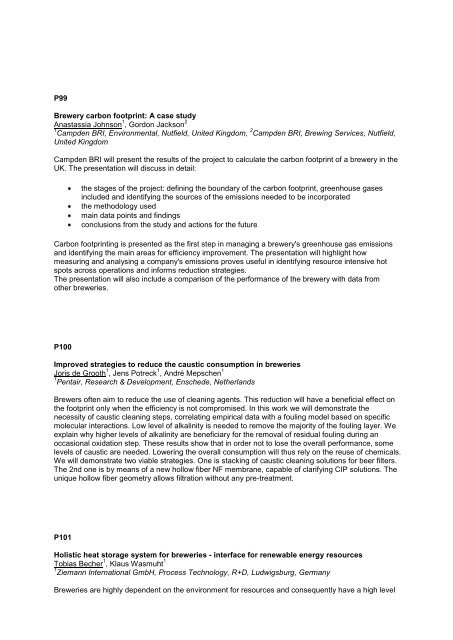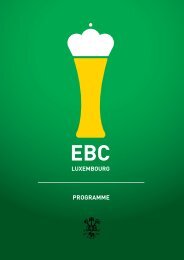here - the 34th European Brewery Convention
here - the 34th European Brewery Convention
here - the 34th European Brewery Convention
Create successful ePaper yourself
Turn your PDF publications into a flip-book with our unique Google optimized e-Paper software.
P99<br />
<strong>Brewery</strong> carbon footprint: A case study<br />
Anastassia Johnson 1 , Gordon Jackson 2<br />
1 Campden BRI, Environmental, Nutfield, United Kingdom, 2 Campden BRI, Brewing Services, Nutfield,<br />
United Kingdom<br />
Campden BRI will present <strong>the</strong> results of <strong>the</strong> project to calculate <strong>the</strong> carbon footprint of a brewery in <strong>the</strong><br />
UK. The presentation will discuss in detail:<br />
<strong>the</strong> stages of <strong>the</strong> project: defining <strong>the</strong> boundary of <strong>the</strong> carbon footprint, greenhouse gases<br />
included and identifying <strong>the</strong> sources of <strong>the</strong> emissions needed to be incorporated<br />
<strong>the</strong> methodology used<br />
main data points and findings<br />
conclusions from <strong>the</strong> study and actions for <strong>the</strong> future<br />
Carbon footprinting is presented as <strong>the</strong> first step in managing a brewery's greenhouse gas emissions<br />
and identifying <strong>the</strong> main areas for efficiency improvement. The presentation will highlight how<br />
measuring and analysing a company's emissions proves useful in identifying resource intensive hot<br />
spots across operations and informs reduction strategies.<br />
The presentation will also include a comparison of <strong>the</strong> performance of <strong>the</strong> brewery with data from<br />
o<strong>the</strong>r breweries.<br />
P100<br />
Improved strategies to reduce <strong>the</strong> caustic consumption in breweries<br />
Joris de Grooth 1 , Jens Potreck 1 , André Mepschen 1<br />
1 Pentair, Research & Development, Enschede, Ne<strong>the</strong>rlands<br />
Brewers often aim to reduce <strong>the</strong> use of cleaning agents. This reduction will have a beneficial effect on<br />
<strong>the</strong> footprint only when <strong>the</strong> efficiency is not compromised. In this work we will demonstrate <strong>the</strong><br />
necessity of caustic cleaning steps, correlating empirical data with a fouling model based on specific<br />
molecular interactions. Low level of alkalinity is needed to remove <strong>the</strong> majority of <strong>the</strong> fouling layer. We<br />
explain why higher levels of alkalinity are beneficiary for <strong>the</strong> removal of residual fouling during an<br />
occasional oxidation step. These results show that in order not to lose <strong>the</strong> overall performance, some<br />
levels of caustic are needed. Lowering <strong>the</strong> overall consumption will thus rely on <strong>the</strong> reuse of chemicals.<br />
We will demonstrate two viable strategies. One is stacking of caustic cleaning solutions for beer filters.<br />
The 2nd one is by means of a new hollow fiber NF membrane, capable of clarifying CIP solutions. The<br />
unique hollow fiber geometry allows filtration without any pre-treatment.<br />
P101<br />
Holistic heat storage system for breweries - interface for renewable energy resources<br />
Tobias Becher 1 , Klaus Wasmuht 1<br />
1 Ziemann International GmbH, Process Technology, R+D, Ludwigsburg, Germany<br />
Breweries are highly dependent on <strong>the</strong> environment for resources and consequently have a high level





